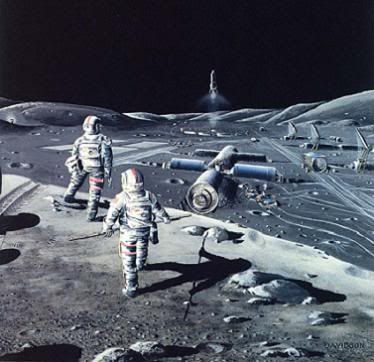Post by glactus on Sept 14, 2011 1:09:11 GMT
For many years we have used energy provided by the sun to generate electrical power in space but we have yet to use any material resources. The Moon is the nearest object offering usable resources. Contrary to common belief, the lunar surface contains virtually all the elements one needs to create usable products for human space faring, including air, water and rocket propellant.

A Lunar landing site
It’s often said that the Moon is resource-poor. That is inaccurate; the Moon is resource different. It is depleted in volatile substances (those that have very low melting points). The most important rare resource on the Moon is hydrogen. The Moon itself has very little of this element, but the soils have a great deal of it; because the Moon has no atmosphere or global magnetic field, the stream of protons from the Sun (the solar wind) implants hydrogen onto the surface of the dust grains on the Moon. This solar wind hydrogen can be released through heating of the dust. When you have both hydrogen and oxygen, you have air, water, and rocket propellant.

The Lunar base
The typical hydrogen concentration in most soils is 20 to 100 parts per million. This is enough quantity to extract and use, especially if much of the mining and processing work is done through robotic machines operated from Earth. Hydrogen appears to be present in higher quantities in soils that have high titanium content, which are abundant on the lunar near side (the Apollo 11 landing site has one of the highest titanium contents found on the Moon to date).

The Lunar mining site
Now there are even more exciting resource prospects. The Moon has abundant hydrogen at the poles enriched by more than a factor of three over the global average. Some of this hydrogen, present in the permanently dark and cold floors of polar craters, may be in the form of water ice.
Additionally, with the spin axis of the Moon perpendicular to the plane of its orbit around the Sun, some peaks near the poles appear to be in near-permanent sunlight, permitting continuous collection and use of solar electrical power, as well as the important benefit of a near constant surface temperature.
For these reasons, recent international exploration of the Moon has focused on the poles of the Moon, where extracting and using lunar resources is easiest and where humans have the greatest potential to learn how to live off-planet and exploit space resources to create routine access in cislunar space and into the Solar System.

Credits: These are NASA.JPL images
Text by Wikipedia

A Lunar landing site
It’s often said that the Moon is resource-poor. That is inaccurate; the Moon is resource different. It is depleted in volatile substances (those that have very low melting points). The most important rare resource on the Moon is hydrogen. The Moon itself has very little of this element, but the soils have a great deal of it; because the Moon has no atmosphere or global magnetic field, the stream of protons from the Sun (the solar wind) implants hydrogen onto the surface of the dust grains on the Moon. This solar wind hydrogen can be released through heating of the dust. When you have both hydrogen and oxygen, you have air, water, and rocket propellant.

The Lunar base
The typical hydrogen concentration in most soils is 20 to 100 parts per million. This is enough quantity to extract and use, especially if much of the mining and processing work is done through robotic machines operated from Earth. Hydrogen appears to be present in higher quantities in soils that have high titanium content, which are abundant on the lunar near side (the Apollo 11 landing site has one of the highest titanium contents found on the Moon to date).

The Lunar mining site
Now there are even more exciting resource prospects. The Moon has abundant hydrogen at the poles enriched by more than a factor of three over the global average. Some of this hydrogen, present in the permanently dark and cold floors of polar craters, may be in the form of water ice.
Additionally, with the spin axis of the Moon perpendicular to the plane of its orbit around the Sun, some peaks near the poles appear to be in near-permanent sunlight, permitting continuous collection and use of solar electrical power, as well as the important benefit of a near constant surface temperature.
For these reasons, recent international exploration of the Moon has focused on the poles of the Moon, where extracting and using lunar resources is easiest and where humans have the greatest potential to learn how to live off-planet and exploit space resources to create routine access in cislunar space and into the Solar System.
Credits: These are NASA.JPL images
Text by Wikipedia


